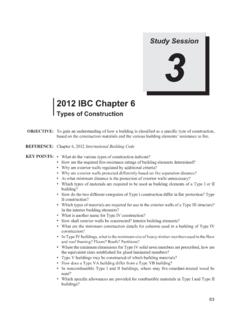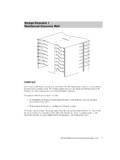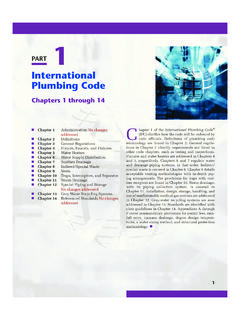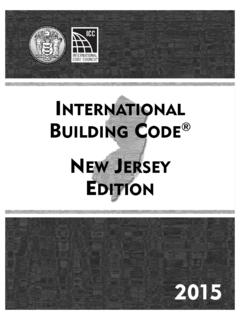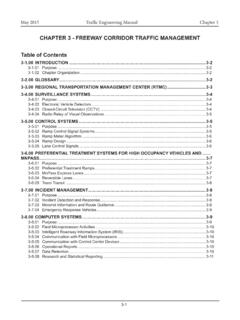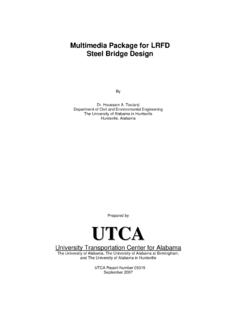Transcription of Chapter 3: Use and Occupancy Classification - iccsafe.org
1 Chapter 3: Use and Occupancy Classification General Comments I construction is the Classification that generally requires the highest fire-resistance ratings for structural ele- Chapter 3 provides for the Classification of buildings, ments, whereas Type V construction, which is desig- structures and parts thereof based on the purpose or nated as a combustible type of construction, generally purposes for which they are used. requires the least amount of fire-resistance-rated struc- Section 302 identifies the Occupancy groups into tural elements. If one then looks at Tables , which all buildings, structures and parts thereof must be and , the relationship among group Classification , classified. allowable heights and areas and types of construction Sections 303 through 312 identify the Occupancy becomes apparent. Respective to each group classifica- characteristics of each group Classification . In some tion, the greater the fire-resistance rating of structural sections, specific group classifications having require- elements, as represented by the type of construction, ments in common are collectively organized such that the greater the floor area and height allowances.
2 The one term applies to all. For example, Groups A-1, A-2, greater the potential fire hazards indicated as a function A-3, A-4 and A-5 are individual groups. The general of the group, the lesser the height and area allowances term Group A, however, includes each of these individ- for a particular construction type. ual groups. For this reason, each specific assembly As a result of extensive research and advancements group Classification is included in Section 303. in fire technology, today's building codes are more com- Definitions play a key role in determining the occu- prehensive and complex regulatory instruments than pancy Classification . All definitions are located in Chap- they were in the earlier years of code development. ter 2. This Chapter lists key definitions for Classification While the principle of equivalent risk remains an impor- of occupancies. tant component in building codes, perspectives have In the early years of building code development, the changed and life safety is now the paramount fire issue.
3 Essence of regulatory safeguards from fire was to pro- Even so, Occupancy Classification still plays a key part vide a reasonable level of protection to property. The in organizing and prescribing the appropriate protection idea was that if property was adequately protected from measures. As such, threshold requirements for fire pro- fire, then the building occupants would also be pro- tection and means of egress systems are based on tected. Occupancy Classification (see Chapters 9 and 10). From this outlook on fire safety, the concept of equiv- Other sections of the code also contain requirements alent risk has evolved in the code. This concept main- respective to the Classification of building groups. For tains that, in part, an acceptable level of risk against the example, Section 705 addresses requirements for exte- damages of fire respective to a particular Occupancy rior wall fire-resistance ratings that are tied to the occu- type (group) can be achieved by limiting the height and pancy Classification of a building and Section area of buildings containing such occupancies accord- contains interior finish requirements that are dependent ing to the building's construction type ( , its relative upon the Occupancy Classification fire endurance).
4 The concept of equivalent risk involves three interde- pendent considerations: 1. The level of fire hazard asso- Purpose ciated with the specific Occupancy of the facility; 2. The The purpose of this Chapter is to classify a building, reduction of fire hazard by limiting the floor areas and structure or part thereof into a group based on the spe- the height of the building based on the fuel load (com- cific purpose for which it is designed or occupied. bustible contents and burnable building components); Throughout the code, group classifications are consid- and 3. The level of overall fire resistance provided by ered a fundamental principle in organizing and prescrib- the type of construction used for the building. ing the appropriate features of construction and The interdependence of these fire safety consider- occupant safety requirements for buildings, especially ations can be seen by first looking at Tables 601 and general building limitations, means of egress, fire pro- 602, which show the fire-resistance ratings of the princi- tection systems and interior finishes.
5 Pal structural elements comprising a building in relation to the five classifications for types of construction. Type 2015 INTERNATIONAL BUILDING CODE COMMENTARY 3-1. USE AND Occupancy Classification . SECTION 301 applied. Each specific group has an individual classi- GENERAL fication. Each represents a different characteristic Scope. The provisions of this Chapter shall control the and level of fire hazard that requires special code Classification of all buildings and structures as to use and provisions to lessen the associated risks. There are Occupancy . some group classifications that are very closely related to other specific groups and, therefore, are As used throughout the code, the Classification of an collectively referred to as a single group ( , Group Occupancy into a group is established by the require- F applies to Groups F-1 and F-2). In these cases, ments of this Chapter . The purpose of these provi- there are requirements within the code that are com- sions is to provide rational criteria for the mon to each specific group Classification .
6 These com- Classification of various occupancies into groups mon requirements are applicable based on the based on their relative fire hazard and life safety reference to the collective Classification . For example, properties. This is necessary because the code uti- the automatic sprinkler system requirement of Sec- lizes group Classification as a fundamental principle tion applies to each specific group classifica- for differentiating requirements in other parts of the tion (R-1, R-2, R-3 and R-4) listed under the term code related to fire and life safety protection. Group R. Although many requirements applicable to a general Occupancy Classification are the same for all of the subclassifications within the Occupancy SECTION 302 group, there are enough differences to warrant the Classification division of the general category into two or more spe- General. Structures or portions of structures shall be cific classifications.
7 Classified with respect to Occupancy in one or more of the Example: Both a restaurant (Group A-2) and a groups listed in this section. A room or space that is intended church (Group A-3) are included in Group A, but they to be occupied at different times for different purposes shall have different specific group classifications. Both comply with all of the requirements that are applicable to Groups A-2 and A-3 are subject to the same travel each of the purposes for which the room or space will be distance limitations (see Table ) and corridor occupied. Structures with multiple occupancies or uses shall fire-resistance ratings (see Table ), but have comply with Section 508. Where a structure is proposed for a different thresholds for when automatic sprinkler sys- purpose that is not specifically provided for in this code, such tems are required (see Section 903). structure shall be classified in the group that the Occupancy Buildings that contain more than one Occupancy most nearly resembles, according to the fire safety and rela- group are mixed Occupancy buildings.
8 Buildings with tive hazard involved. mixed occupancies must comply with one of the 1. Assembly (see Section 303): Groups A-1, A-2, A-3, design options contained in Section 508. Options A-4 and A-5. established in Section 508 include the regulation of the mixed- Occupancy conditions as accessory occu- 2. Business (see Section 304): Group B. pancies, nonseparated occupancies or separated 3. Educational (see Section 305): Group E. occupancies. 4. Factory and Industrial (see Section 306): Groups F-1 Occasionally, a building or space is intended to be and F-2. occupied for completely different purposes at differ- ent times. For instance, a church hall might be used 5. High Hazard (see Section 307): Groups H-1, H-2, H-3, as a day care center during weekdays and as a H-4 and H-5. reception hall for weddings and other similar events 6. Institutional (see Section 308): Groups I-1, I-2, I-3 at other times. In these cases, the code provisions for and I-4.
9 Each Occupancy must be satisfied. 7. Mercantile (see Section 309): Group M. In cases where a structure has a purpose that is not specifically identified within any particular occu- 8. Residential (see Section 310): Groups R-1, R-2, R-3 pancy Classification , that structure is to be classified and R-4. in the group that it most closely resembles. Before an 9. Storage (see Section 311): Groups S-1 and S-2. accurate Classification can be made, however, a detailed description of the activities or processes tak- 10. Utility and Miscellaneous (see Section 312): Group ing place inside the building, the occupant load and U. the materials and equipment used and stored therein This section requires all structures to be classified in must be submitted to the building official. The building one or more of the groups listed according to the official must then compare this information to the var- structure's purpose and function ( , its Occupancy ).
10 Ious Occupancy classifications, determine which one By organizing occupancies with similar fire hazard the building most closely resembles and classify the and life safety properties into groups, the code has building as such. incorporated the means to differentiate occupancies Example: A designer presents the building official such that various fire protection and life safety with a building needing an Occupancy group classifi- requirements can be rationally organized and cation. The building official is informed that the build- 3-2 2015 INTERNATIONAL BUILDING CODE COMMENTARY. USE AND Occupancy Classification . ing is to be used as an indoor shooting gallery, open tations of Tables , and , which are, to the public but used mostly by police officers. After in comparison, generally more restrictive than for reviewing the code, the official cannot find a specific buildings in other group classifications. reference to a shooting gallery in Sections 303 A room or space with an occupant load of 50 or through 312 or in the associated tables.
